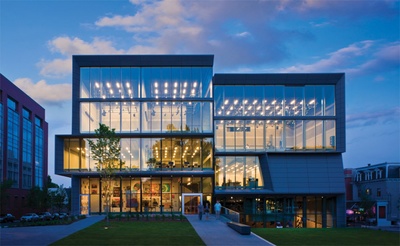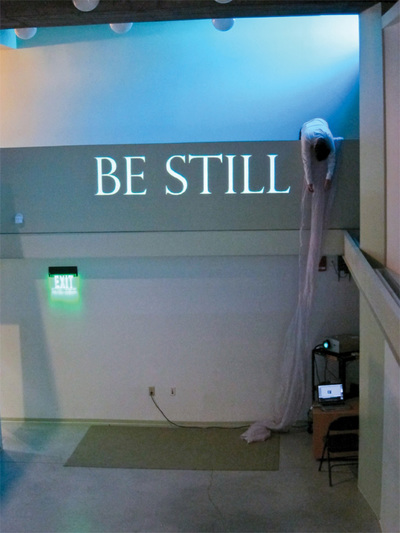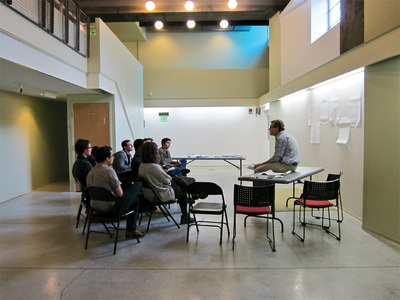Making Space
There has been a notable increase in creative arts spaces on college campuses across the United States. It is a clear sign of universities taking notice and making it known that the arts and the creative process inherent in art-making are important to the lives of all undergraduate university students, whether or not their studies are focused on the arts. However, the best way to teach, study and make “practical” the creative arts and the creative process within a university setting is often a hotly contested topic within the academy.
Arguably, most of what we do in life has a creative process underlying it, and by investing in this process, we progress. Consider how much more adept we are even at writing than we used to be, or maybe it’s public speaking, or even driving a car since the more we practice, the more we discover the way things work, and the more we go on to attempt new things. By virtue of this process of repetition, we can and do improve. Now, consider the power of providing undergraduate students the ability to appreciate the importance of this repetition in their own ideas and discoveries. Giving all students the ability to unlock the gears that underlie their own invention, innovation, and creativity can add an enormous lever to their toolbox and to the future we all will share.

Perry and Marty Granoff Center for the Creative Arts at Brown University.
Photo: Warren Jagger Photography/www.jaggerfoto.com.
Enter the University Creative Arts Space
Creative arts spaces on college campuses are becoming more common. New England examples include Brown’s Granoff Center, opened in January 2011; Dartmouth’s Black Family Visual Arts Center opened in September 2012; and Harvard’s Arts @ 29 Garden, opened in October 2010. And there are many other creative arts spaces popping up in universities all across the country. Over time, these spaces become an important part of their local communities as well as their given university community, providing a venue for dialogue and debate, and exemplifying a commitment to bringing pedagogically close creativity, the arts, and the creative process.
What Exactly Goes On in These Spaces?
Typically, creative arts spaces house interdisciplinary classrooms and practice spaces of all kinds all under one roof—seminar rooms and classrooms, rehearsal spaces, brainstorming spaces including digital labs, and performance spaces of various configurations. The idea for related learning directions happening simultaneously is, of course, part of the power of these new creative arts spaces. Rather than typical siloing of various disciplines in universities, these spaces are literally symbolic of universities making space for collaboration and feedback across disciplines, and in so doing recognizing the value that creativity brings to problem-solving skills in any context. In these newly architected environments, students invest in broader ways of thinking and envisioning so that they may emerge from college/university with a sense of their own capabilities and potential.
Poet Brewster Ghiselin wrote in the introduction to his now classic anthology entitled The Creative Process (first edition 1952), “Insight into the process of invention can increase the efficiency of almost any developed and active intelligence.” Contributors to The Creative Process ranged from Vincent van Gogh through D.H. Lawrence, Albert Einstein, Jean Cocteau, Gertrude Stein, and many others. The process of discovery, that is, learning how to manage the original ideas we have and then seeing them through to some sort of fruition, is also one of the most important lessons students learn graduating from college. Considering the interdisciplinary nature of the process of discovery, the creative process inherent in the arts and art-making is transferable to other fields of knowledge. Allowing for how much focus is placed on being able to move seamlessly across our ever-increasing worlds—the digital world, the written word, the realm of social media—teaching students a process by which they can meld their ideas with their actions and eventually their products becomes highly important and strategic.

At Harvard’s Arts @ 29 Garden, students make use of the unique space to
realize creative solutions to curricular assignments. Photo: Bess Paupeck.
Historically, the creative arts and its procedures have not always been widely accepted as essential to a college education, and therefore are not always valued in the infrastructures designed to strength-en student life. The challenge, of course, is to deem the journey of discovery found within the art-making process as important as everything else that is part of an undergraduate curriculum. To establish a place for the creative arts, the goal has been to find rigor in art-making that matches hours spent in the chemistry lab or poring over a mathematical proof, such as admitting of parallels in twenty hours per week spent in rehearsal or weekends spent in the ceramics or painting studio. The process of discovery as it pertains to the arts—the creative process—is as long, arduous, and magical a journey into the self as is engaging with the scientific process or any other processes of discovery found looking outward in other disciplines. No student comes away from the experience of discovery unchanged. This is perhaps the core of a liberal arts education.
The “Crit”
The importance of feedback and the “crit” in the arts is integral to learning and a huge part of the creative process. This sort of skill set is not taught as readily in other disciplines, but its potential to inspire progress and growth is astounding. The incomparable Liz Lerman, a Baltimore-based choreographer and winner of a MacArthur “Genius Grant” Fellowship in 2002 (amongst many other honors), wrote Critical Response Process (CRP) in 2003. Lerman shares the ways through which she discovered a positive and progressive way to give and receive criticism in a creative environment. With CRP, she provides a simple set of rules to follow during a critique that places a structure around the process of criticism in such a way that participants feel less criticized and more nurtured. For example, instead of responding to a work by saying, “I thought the dance went on for too long,” the idea is to say, “What was your goal in having the dance be the length that it is?” This simple adjustment more likely can lead to a fruitful conversation to create useful analysis and real progress. This feedback, so integral to any art-making experience, can be translated to other parts of life. As Liz Lerman demonstrates with CRP, the ability to connect with someone over a shared art experience is not only integral to one’s own learning, but it is also a profoundly human way to connect and grow. Through the formalized process of critique, development happens.

Advanced German language students, writing and performing improvisation in
class at Harvard’s Arts @ 29 Garden as means of improving language skills,
gather round to hear feedback from their instructor. Photo: Bess Paupeck.
Consider the similarities between the scientific process, which leads to innovation in science and the creative process, which leads to creation and production within the arts. The scientific process, with its understanding of the importance of trial and error (often over the course of years) is the journey that all students learn to investigate during the obligatory hours of lab required in a science course. Consider now a dance course, for which students must rehearse for hours in order to acquire a passing grade. The hours of rehearsal time can and should be viewed as typical of homework or lab time that accompanies other courses, but there is typically no planned lab time for dance courses. The actual need for lab or process time, set aside outside of class, is clearly as important in both disciplines, yet why is it that art and making classes do not set aside and account for the additional time?
The actual commitment to space dedicated to the practice of creativity, offering students that much-needed lab space for creativity is, in a sense, a huge step forward in the struggle to keep the arts as integral a part of an undergraduate existence as possible.

Visitors to the student exhibition space in the Black Family Visual Arts
Center take a close look at an untitled work by Gwendolyn Tetirick, 2013.
Photo by Eli Burakian, Class of 2000.
The Centrality of the Creative Art Space
Imagine a world where, from the science lab to the art studio, from the boardroom to the theater, the creative process is fully enabled, allowing us all to see a problem from varying perspectives and to arrive at creative solutions that fully engage with one another in a meaningful way. When such solutions to the world’s problems are what we need, why wouldn’t we arm students with a nimble ability to grasp and see a problem from all sides? The creative arts and all that comes with them, the process of the “crit” and the resulting collaborative and nurturing environment, have a central place within the university and generate powerful, exponential, results. Embedding art-making and the creative process in university curricula by means of a dedicated creative arts space only provides strength to future artists, entrepreneurs, scientists, writers, and makers of every kind.
Bess Paupeck is the program manager at Arts @ 29 Garden, Harvard University’s newest art space, and a graduate student at Brown University in the Public Humanities program. She has also worked at the Museum of Fine Arts, Boston, the Museum of Science, Boston, and the City of Somerville Arts Council.
